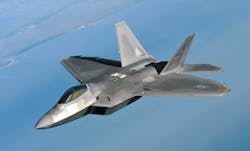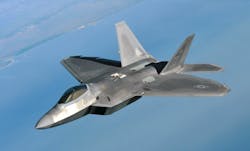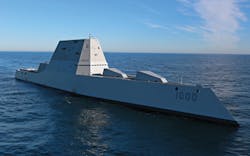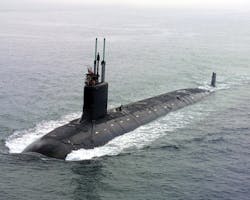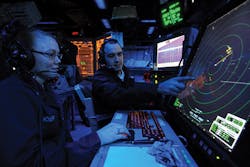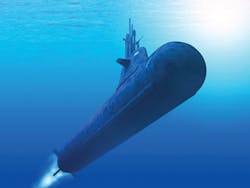New frontiers in passive radar and sonar
Passive sensor systems may be ready to come into their own, as high-performance embedded computing technology becomes powerful enough to handle the massive computing load that passive systems require in targeting stealthy aircraft and submarines.
By J.R. Wilson
Radar and sonar technologies came into their own as pivotal capabilities in World War II, during the Battle of Britain, the Battle of the Atlantic, and many other battles that helped shape the latter half of the 20th Century. Research in the 1930s led to widespread deployment of active radar and sonar systems across three operational domains - air, land, and sea - during and after World War II.
For the past half century, efforts to defeat both have spawned generations of stealth technology and a renewed focus on passive radar and sonar, which actually predate active systems by three decades.
Radar, short for radio detection and ranging, bounces radio waves off objects to calculate their distances from the RF transmitter. Sonar, which stands for sound navigation and ranging, bounces sound waves off objects to calculate their distances from the sound transmitter. Most often sonar is for detecting and locating surface vessels, submarines, or other maritime objects for detection and tracking or to assist navigation and obstacle avoidance.
The biggest drawback to both is they are the equivalents of flashlights in the dark: While they help the user illuminate targets of interest, they also help others see the location of the user. That has led to development of less visible approaches that involve RF and sound transmitters that appear to be causing random noise, rather than conducting a determined search.
"There are spread-spectrum transmissions for radar that is an active technique that, instead of a blatant pulse train, it appears you are putting out noise and it's not as obvious you're there," says Marc Couture, senior product manager, digital signaling at Curtiss-Wright Defense Solutions in Ashburn, Va.
Passive radar and sonar systems, however, do not generate their own signals at all. They capitalize on existing signals in the environment, and the passive radar and sonar receivers essentially just listen for those signals and use power signal processing to sort these signals into useful information.
"With passive techniques, you rely on the environment to light up objects," Couture says. "In 2016, there are a lot of things that light up everything around you in terms of radio emissions. With passive radar, radio waves bouncing off each other from a host of other sources can give you a picture without sending out your own pulse. That also is true with sonar - if you have a sensitive enough system, you can pick up objects without sending out a ping."
Sensitive sensors
"Both require extremely sensitive sensors, certainly more than just one single-point sensor, and a lot more processing," Couture explains. "If you think of radar, you put out a pulse train and expect it to come back, modified by whatever it bounces off. With passive, you're using reflections off clutter and buildings to pull out a target in the sky, so there is a lot more work to correlate all those different wavefronts."
One way to understand that is to look at the downfall of H.G. Wells's Invisible Man character, who could be seen - and tracked - when his invisible body caused what appeared to be a bubble in rain or fog.
In the real world, of course, stealth platforms are not invisible to the naked eye, but appear as something else - usually much smaller - on radar or sonar. There have been two primary ways to do that: special shaping, such as used on the F-117 Nighthawk, the world's first stealth aircraft - or special materials that absorb rather than reflect radar signals, as used on the second stealth aircraft, the F-22 Raptor.
Both methods also have been used on surface and subsurface naval vessels, such as the Navy's new Zumwalt-class guided missile destroyers and Virginia-class attack submarines. More recently it's been used in designs for next-generation unmanned aerial vehicles (UAVs).
These platforms represent the U.S. military's generational lead in stealth over the rest of the world and proved vital to air superiority in the first and second Gulf wars. But a future conflict with a technologically near-peer adversary - such as China, Russia, or Iran - or nations they support could see that advantage melt way. Not because those nations are developing their own stealth platforms - which they have been working on for years - but because they are concentrating on far less expensive and easily deployed counter-measures.
"Faced with the prospect of aerial stealth proliferation, states in the 21st Century are looking for anti-stealth defense options. One such alternative, passive radar, appears a cost-effective counter to stealth," according to an October 2009 National Defense University (NDU) report, "Radar vs. Stealth: Passive Radar and the Future of U.S. Military Power," that is even more pertinent today.
Finding stealth aircraft
"Integrating a system of netted re- ceivers, passive radar can detect, track, and target piloted and unpiloted stealth systems and provide cuing for anti-air weapons systems," the report states. "A passive radar system emits no radio energy and can be well camouflaged in urban and rural landscapes. The threat system produces no indications on friendly radar warning receivers and is difficult to locate and target. Faced with a passive radar threat, the United States may find itself unable to achieve air superiority at an acceptable cost."
Essentially, passive systems reverse the concept of stealth, from hiding ships and aircraft from radar and sonar to hiding radar and sonar from those platforms. Which explains why much of the public literature on passive radar and sonar is coming from China, Iran, and Russia.
"Ongoing advances in passive radar will deny traditional means to defeat enemy air defenses, make air superiority difficult to achieve against a passive radar opponent, and require changes in thinking to maintain U.S. power projection capability," according to the NDU report.
In February 2015, an online affiliate of Russian newspaper Rossiyskaya Gazeta announced Russia's top five most effective electronic warfare (EW) systems. Number two on that list was the Moskva-1, a passive radar system that enables Russian troops to detect and identify airborne targets as far as 240 miles away while their own position remains hidden.
As global communications systems continue to advance and proliferate, the availability of opportunity illuminators increases, as well as not only land-based systems, but also satellites. One of the newest systems showing great potential for passive radar is long-term evolution (LTE), which has greatly improved cell phone signals.
"Experimental results showed that the LTE-based passive radar system has the capability to detect car, motor bike, and human body moving with various speeds, such as 10, 20, 30, and 40 kilometers per hour, and they are detected at different ranges from zero to 130 meters. Therefore, from the experimental results, there is no doubt that the LTE signal can be utilized as a signal source for PBR [Passive Bistatic Radar] system," according to researchers at Universiti Putra Malaysia.
Research in passive systems
"In spite of the positive results obtained, it should be pointed out that there is still a need for further studies and improvements," researchers say. "A future study could include implementing advanced signal processing algorithms for improving detection accuracy. Furthermore, more experiments could be conducted for investigating the system's capability for detecting and tracking of moving targets at a very low speed and low target profile."
At the University of Strathclyde in Scotland, researchers also looked at the Global Navigation Satellite System (GNSS) as a source of illumination for passive radar, including the possibility of exploiting GNSS as an opportunity illuminator to measure the micro-Doppler signature of helicopter rotor blades.
This approach represents "a system exploiting the energy transmitted from these non-cooperative transmitters... and has been successfully investigated in different configurations and using different sources of illumination," University of Strathclyde experts reported. "This kind of technology has several advantages thus opening to many applications for civilian and military purposes. Exploiting an existing source of RF energy, the system can be cheaper, stealthier, frequency allocation-free, and provide the capability to have information in portions of the spectrum unavailable in the past."
Active sonar can be a greater danger to the submarine using it than active radar is to an aircraft, which has significantly limited military use of it, as described by former U.S. Navy attack submarine sonar technician Steve Jacobs in response to a question on Quora.com, an online service providing expert answers to questions on any topic.
"In order to detect a contact with a ping, the sound has to travel at least two times the distance between the target and the submarine, plus have enough energy when it arrives to be detected by the submarine. If the sub (or any ship) is automatically pinging, the 'range gate' lets others know what distance the ship transmitting can detect contacts as well as what kind of sonar is being used," he wrote. "The only time we've pinged in a tactical situation is to take a single ping to verify a final range to a target we were going to engage with a torpedo."
The rising interest in and use of passive systems does not mean America's stealth platforms are obsolete nor the nation's multi-billion dollar investment in them was wasted. Stealth gave U.S. forces a distinct military advantage in Iraq, during Operation Desert Storm and Operation Iraqi Freedom, and Operation Enduring Freedom-Afghanistan and continue to aid in U.S. military operations against ISIS.
Big challenge to stealth
The ongoing development of passive systems by nations that supply equipment to Second and Third World nations hostile to the United States is likely to reduce their stealth effectiveness severely in the years to come.
This has led some of the U.S. military's top officers to question the wisdom of relying too heavily on stealth to counter the anti-access and area-denial (A2/AD) threat American aircraft are certain to face in future conflicts. Chief among those has been Chief of Naval Operations Adm. Jonathan Greenert, who says "if something moves fast through the air, disrupts molecules and puts out heat... it's going to be detectable."
That also was the conclusion of a January 2014 paper by the Center for a New American Security: "One recent analysis argued that there has been a revolution in detecting aircraft with low RCS [radar cross-section], while there have not been commensurate enhancements in stealth."
Curtiss-Wright's Couture, however, sees passive systems not as the enemy of stealth but as a significant part of future stealth systems.
"With passive, it's part of being stealthy. But it's not just the shape of the aircraft and materials that cut down the radar cross-section; now you have sensors that don't light up the aircraft after you've done all that to try to hide it. So it will give us an advantage - although there are some adversaries that will catch up and find ways to hide themselves. So how do we find them?" he says.
"A lot of passive will be in more stand-off platforms that may assist special operations but not be part of it. You'll be able to map out the actual war theater in incredible detail without being detected. It's about prosecuting an enemy target and they don't know you're coming," Couture continues. "If a drone is using passive radar techniques, as long as it has enough power, you won't see it coming on a radar screen and you're zapped before you even know it. So the first nations to field that kind of capability will have an advantage."
Nazi Germany employed a passive bistatic radar system during World War II, using Britain's own Chain Home radars as non-cooperative illuminators to reveal the presence of aircraft flying over the southern part of the North Sea. Even so, bistatic radar systems were largely replaced by monostatic systems as early as the late 1930s. As the transmitter and receiver systems became smaller, it became possible to place them on aircraft and most ships. Bistatic systems regained some attention when scientists discovered useful properties in scattered radar energy.
Those experiments and others led to the 1955 deployment of the AN/FPS-23 fluttar bistatic radar system along the North American Distant Early Warning (DEW) Line to detect low-flying bombers. That system remained part of the DEW Line for about five years.
Passive radar saw its own initial resurgence in the 1980s as computing power and digital receiver technology began rapid increases in capability, allowing digital signal processing exploiting a variety of non-cooperative opportunity illuminators and, for the first time, cross-correlation techniques to detect targets and estimate their ranges. Many nations conducted classified development in this area, but the first public announcement came in 1998 with the launch of Lockheed-Martin's commercial Silent Sentry system, exploiting FM radio and analog television transmitters as opportunity illuminators.
Processing requirements
'We like to build high-performance embedded computers with all sorts of embedded processing technology. With passive radar and sonar, you need a lot more processing because you have a lot more data to collect and correlate. And when sensors are more sensitive, analog to digital converters have a higher bit rate, which means the actual high-resolution data is much larger," Couture says.
"If you have 16 channels instead of four, for example, you end up with a fire hose of data. With passive radar, the actual techniques are quite intensive. The processing technologies weren't there before, but now the densities are so high in computing you can think about using these in mobile platforms."
Relying on environmental RF and microwaves to light up the object, instead of a radar pulse and very specific radar stacks and algorithms honed in on that return pulse, the algorithms are far more intensive, correlating wavefronts from stationary and moving surface objects," he says. "In the past, that has been a major roadblock to using passive radar on smaller platforms, such as UAVs, that have a limited payload for volume and power.
"With this advanced processing power, you need to process all these new algorithms to track objects without giving away your location, which is especially valuable for stealth aircraft," Couture continues. "And that trend will continue as we have more cores and get more parallel, providing more density performance per watt, so you will see more algorithms coming off the shelf at DARPA and MIT that were not affordable and were too intensive in the past. It's not just one algorithm that fits all scenarios - you will use different ones over urban areas than deserts, for example."
Much work needs to be done in the digital signal processing community before this could be considered a mature technology. "It is really very early, so what is out there now is primitive compared to what will be out there in the future, maybe a decade from now," Couture says. "That will be riding the continuation of Moore's Law on processing, new algorithm development, dealing with stealth technologies. With conformal antennas you can absorb from all directions, which increases the data hose. A communications band that used to be 20 MHz to 3 Gig has now expanded out to 6 Gig and the classic EW bands have expanded to 27 Gig. Some new radars also operate at a higher frequency, so there are new wavelengths to prosecute; to use these passive techniques, you need more processing to deal with more channels and wider bandwidth."
In a 2015 paper, "Target Tracking and Receiver Placement in MIMO DVB-T Based PCL" from Iran's Sharif University of Technology, researchers looked at the electronic warfare applications of using multiple antennas for transmission and reception of a passive radar system in a multiple input/multiple output (MIMO) configuration.
"The idea of using multiple of such illuminators to get the advantages of MIMO technology, besides the advantages of passive illumination, is new and attractive," they wrote. "An excellent candidate of such configuration is a DVB-T [Digital Video Broadcasting-Terrestrial] SFN (single frequency network). Various obstacles and considerations appear when working with a MIMO DVB-T based passive radar system. Using the commercial transmitting stations already working in the environment as the non-cooperative transmitter of the radar system makes the radar covert."
Electronic warfare
"This passive radar - or namely PCL (passive coherent location) - is resilient to electronic countermeasures which use the signals emitted by the radar. In such passive systems, two sets of antennas are used: one for receiving the direct signal from its main source (reference antenna) and another one for collecting reflections arriving from the targets (reflection antenna). Here, detection is done through computation of CAF (Cross Ambiguity Function)... which shows how much correlation exists between reference and reflected signals. A CAF's peak in the range Doppler board is representative of a target candidate."
In July 2015, researchers at Pakistan's National University of Sciences and Technology reported on the effects on the range measurement accuracy of a Wi-Fi-based passive radar when multiple copies of signal, from the same target, are received due to propagation through a rich-scattering environment.
"These multipath returns from stationary scatters induced range measurement inaccuracies in passive radars including offset of the target from its true range, smearing of the target in range dimension, or appearance of ghost targets," they wrote. "Relationship between range measurement inaccuracies due to target multipaths and range resolution of transmission waveform has been studied. A two-step solution, that is, signal separation followed by equalisation, is also proposed to mitigate the effects of multipaths in Wi-Fi-based passive radars.
"Long-range surveillance applications of passive radars, using various analog and digital waveforms, have reached a point of maturity and practical systems have started to appear in market for various defense and civil applications, like Silent Sentry by Lockheed Martin, Celldar by Roke Manor Research Limited, and Homeland Alerter 100 by Thales Group. Owing to the many advantages offered by the passive radars, there [also] is a growing interest to utilize them in urban and indoor sensing environments for the detection of human or vehicular targets."
Dealing with weak signals
Three researchers at Villanova University and one from the Air Force Research Laboratory published a paper on "Target Localization in a Multi-Static Passive Radar System Through Convex Optimization" in Signal Processing, a publication of the European Association for Signal Processing, in February 2014. They concluded the use of pre-existing commercial broadcast signals rather than dedicated transmission and receipt stations may be as much a weakness as a strength.
"Compared to conventional active radar systems, which typically operate in a monostatic mode and emit stronger signals with a wide signal bandwidth, MPR [multi-packet reception] systems use broadcast signals which in general are very weak and have an extremely narrow bandwidth. These features make it difficult to exploit an MPR system for accurate target position estimation. In addition, MPR receivers may often be implemented on aerial or ground moving vehicles. In this case, the radar platform may only have inaccurate knowledge about its own instantaneous position. This uncertainty is caused by the accuracy limitation of the positioning system as well as multipath propagations," they wrote.
"Target localization is an important task that has received extensive attention in various applications, such as wireless communications, sensor networks, urban canyon, and through-the-wall radar systems. Specifically, multi-lateration techniques utilize the range information observed at multiple positions, which are distributed over a region, to uniquely localize a target. Depending on the applications, range information can be obtained using time-of-arrival, time-delay-of-arrival, and received signal strength indicator. On the other hand, the observation positions may be achieved using fixed receivers or synthesized using a single moving platform. In the latter case, the receiver positions are subject to inaccuracy."
The ultimate future of passive radar and sonar is still to be determined - as is which nations will achieve the highest levels and broadest applications first and most effectively. Even more than acceptance by military leaders, that will depend on the continued maintenance of American technological leadership through aggressive research and development.
"You can have a fleet of assets that can handle multiple modes and, on top of that, cross-cuing. It's about commanding the entire EM spectrum, which includes not just RF but light and hyperspectral. It's a software-defined platform," Couture says. "The labs are very important because there is always a need for advanced algorithms because we don't have every mode solved or every adversary in check. I can't say I've seen a big pickup in demand [from the military], but I do anticipate it."
